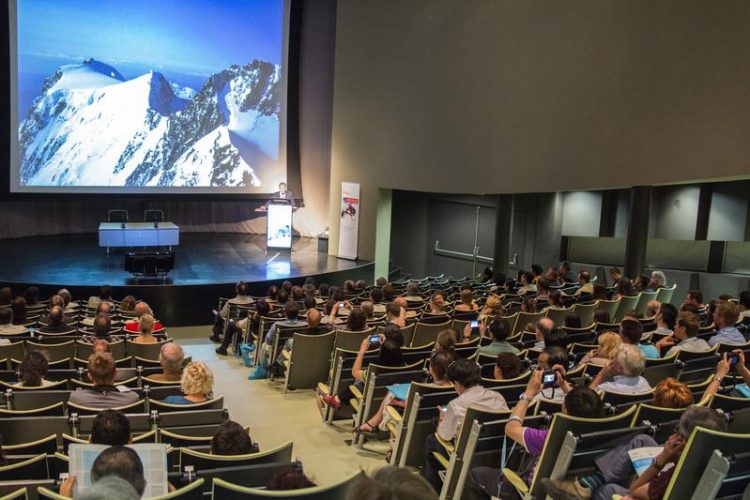New chapter opens in Mountain Medicine

ISMM World Congress 2014 at EURAC Bozen/Bolzano Photo: EURAC
Visitors from 45 countries gathered together at EURAC in Bozen/Bolzano. The World Congress provided the opportunity for experts to decide on establishing common standards for new methods for research and treatment. It is their stated aim to simplify and thereby improve not only data collection, but also diagnosis and therapies for accident victims in mountainous regions all over the world.
10th World Congress on High Altitude Medicine and Physiology draws to a close at EURAC in Bozen/Bolzano
Progress in medical research is based on the exchange of scientific findings, and more especially, on exploring case studies. Whilst general medicine has a vast collection of data to draw on, the fairly recent discipline of High Altitude Medicine is, in this respect, so to speak, still in its infancy.
“Events like this World Congress are bound to play a decisive role in moving on a particular discipline as they create a platform for a direct exchange of ideas at international level,” explained Hermann Brugger and Giacomo Strapazzon, both medical experts at the EURAC Institute for Alpine Emergency Medicine and organisers of the World Congress. The experts assembled in Bozen/Bolzano have therefore determined that the existing collection of medical data on altitude sickness and mountain accidents should become more comprehensive.
The four registers, dealing with hypothermia, high-altitude pulmonary oedema, frostbite and the Alpine Trauma register created by EURAC, have so far resulted in logging case studies from carefully delineated geographical areas. According to a resolution made by the Congress, these registers are now to include mountainous regions all over the world, with clearly established standards.
Hermann Brugger followed exactly the same line when presenting his STAR Project (Strengthen Altitude Research) during the Congress. The stated aim of the project is to set up a network for all research centres working on Mountain Emergency Medicine to work together globally. At the same time, the methodological standards which already apply in traditional emergency medicine are to be extended to embrace alpine contexts.
Exchanging research findings at an international level is of paramount importance for basic research. Research centres from all over the world presented their latest results during the Bolzano Congress, for example on the role played by mitochondria in altitude sickness. Mitochondria which are responsible for oxygen uptake within cells are of prime importance, according to scientists, for adapting to high altitude conditions. During the Congress, experts further discussed potential issues affecting future studies.
Alongside these scientific concerns, delegates also turned their attention to setting up international guidelines for rescue techniques in mountainous areas. Fresh from their experience of the avalanche disaster on Mount Everest in April 2014, Nepalese doctors and members of mountain rescue teams offered their own thoughts and concerns to the international audience in Bolzano and outlined how future mountain rescue services might be organised for the highest peaks in the world.
A training project for doctors, mountain rescue teams and helicopter pilots, started two years ago in Nepal jointly by South Tyrol and Switzerland, featured in their presentation. “We would like to carry on and become trainers ourselves so that we can work with Sherpas and mountain guides who, due to linguistic barriers, are unable to benefit from courses abroad,” stressed Ghan Bahadur Thapa, a Nepalese doctor and mountain rescuer.
“By the same token, we require further support in order to set up an emergency call centre in Nepal which links up and coordinates all existing infrastructures, from the army to private citizens owning helicopters. In this way, we could organise air rescue missions which at present are non-existent,” said Thapa.
http://www.ismm2014.org – Website World Congress on High Altitude Medicine and Physiology 2014
Media Contact
All latest news from the category: Health and Medicine
This subject area encompasses research and studies in the field of human medicine.
Among the wide-ranging list of topics covered here are anesthesiology, anatomy, surgery, human genetics, hygiene and environmental medicine, internal medicine, neurology, pharmacology, physiology, urology and dental medicine.
Newest articles

Properties of new materials for microchips
… can now be measured well. Reseachers of Delft University of Technology demonstrated measuring performance properties of ultrathin silicon membranes. Making ever smaller and more powerful chips requires new ultrathin…

Floating solar’s potential
… to support sustainable development by addressing climate, water, and energy goals holistically. A new study published this week in Nature Energy raises the potential for floating solar photovoltaics (FPV)…

Skyrmions move at record speeds
… a step towards the computing of the future. An international research team led by scientists from the CNRS1 has discovered that the magnetic nanobubbles2 known as skyrmions can be…





















